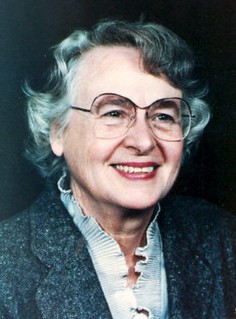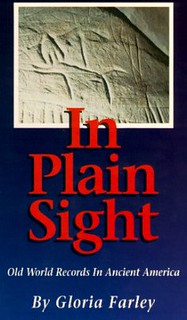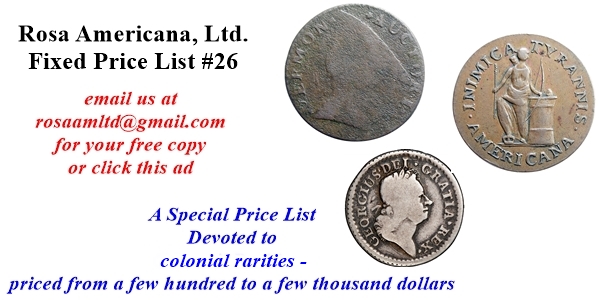
PREV ARTICLE
NEXT ARTICLE
FULL ISSUE
PREV FULL ISSUE
GLORIA STEWART FARLEY (1916-2006)E-Sylum Feature Writer and American Numismatic Biographies author Pete Smith submitted a group of three articles on "Epigraphic Explorer" Gloria Farley and the enigmatic "Farley Coins". Thanks! -Editor
This article was inspired by Julia Casey who reported on
Gloria Stewart Farley (1916-2006)
She was born Gloria Stewart in Heavener, Oklahoma, on October 21, 1916, and spent most of her life there. Her father was a physician, Dr. Matthew Albert Stewart (1876-1947). Her mother was Eunice Virginia Upchurch Stewart (1890-1967).
When Gloria was twelve in the spring of 1928, she visited Poteau Mountain to see an upright stone slab inscribed with mysterious glyphs. This was known at the time as A couple of years later Rosemary saw an article on Runic writing in a Sunday School newspaper and remembered their visit to the site. Gloria rediscovered the stone on February 2, 1951, and named it the Heavener runestone. This began her thirty-five year search for the truth. Gloria quit college after one year to marry Jasper Ray Farley (1914-1983) on March 28, 1937. They had two sons, Mark and Scott. They lived in Missouri for two years and at Washington Court House, Ohio, for eleven years before returning to Heavener in 1950 when Ray was appointed city manager. The population at the time was 2103. In 1948, Gloria read about the Kensington Runestone in Minnesota. She wrote to the Smithsonian about the Heavener Runestone inscription and they had a previous 1923 report from Carl F. Kemmerer. Gloria began to study similar stones in Oklahoma and around the area. She took photographs and made latex molds for plaster casts. Some of the stones she studied have been subsequently moved or lost. In 1953, she began work as a kindergarten teacher, conducting classes in her home. The class that year had ten students. In 1963 she was employed as a caseworker with the LeFlore County Department of Public Welfare.
In 1965, the Heavener Runestone location with 55 acres was donated by Herbert Z. Ward to the public and the Heavener Runestone State Park opened in 1970. The eight-character inscription on the stone has various translations, one of which is
In 1971, Gloria announced the discovery of two more Viking runestones in Oklahoma, bringing the total in the state to nine. The inscriptions were translated by Alf Monge. Some of the stones are believed to include dates represented as puzzles. One explanation of the Heavener Runestone is a cryptographic date of November 11, 1012. Her reports were not broadly accepted.
Dr. Ole G. Landsverk wrote Ancient Norse Messages on American Stones, published in 1969. He said, It was about 1975, that Gloria learned of Barry Fell, a fellow traveler down the paths of epigraphy. Fell also believed that stone inscriptions were the work of Europeans here before Columbus. The two became mutually supportive. In 1977, Fell named Farley as Director of Exploration for the Epigraphic Society. The general academic community views his work as pseudoscience.
In 1976 Gloria was presented with a coin found in Arkansas that was identified as coming from Carthage and struck from 320 to 300 B.C. An article was included in the January 29, 1978, Sunday supplement Family Weekly, distributed with local papers. After this article appeared, readers reported other examples. These have become known as The coins have the general appearance of a Carthaginian Tetradrachm struck around 320 to 300 B.C. The obverse has the head of Arethusa and the reverse has a horse head and uprooted palm tree. Experts consulted by Farley determined they were genuine. In my opinion, they can be easily seen to be modern fantasies. Gloria Farley did not limit her study to Viking runestones. She searched honored for research on the Oklahoma Runestone inscriptions.the country for ancient inscriptions in various languages including Egyptian, Libyan, Basque, and Phoenician. She wrote many articles and lectured around the country. In 1982 she was inducted into the Oklahoma Women's Hall of Fame as an Epigraphic Explorer and
She was a fellow of the Epigraphic Society and the Explorers Club. In 2000, she was presented with the Barry Fell Award by the Midwestern Epigraphic Society. Fell died in 1994 and has generally been discredited. Gloria Farley died in Heavener on March 18, 2006, and is buried with her husband at Hill Cemetery.
On April 17, 2006, the Oklahoma State Senate passed Senate Resolution 87 which stated, The study of pre-Columbian visits to America has always been controversial. Proponents hold to their beliefs and interpret evidence in their favor. Opponents dismiss these as wishful thinking, poor science, and occasionally intentional deception.
Wayne Homren, Editor The Numismatic Bibliomania Society is a non-profit organization promoting numismatic literature. See our web site at coinbooks.org. To submit items for publication in The E-Sylum, write to the Editor at this address: whomren@gmail.com To subscribe go to: https://my.binhost.com/lists/listinfo/esylum All Rights Reserved. NBS Home Page Contact the NBS webmaster 
|




